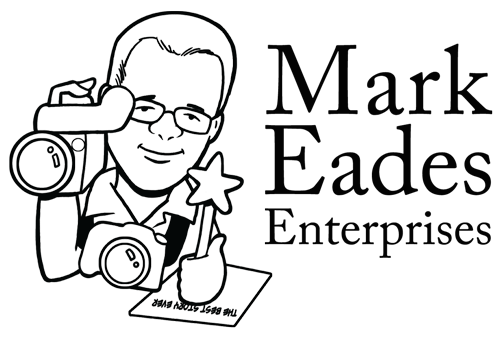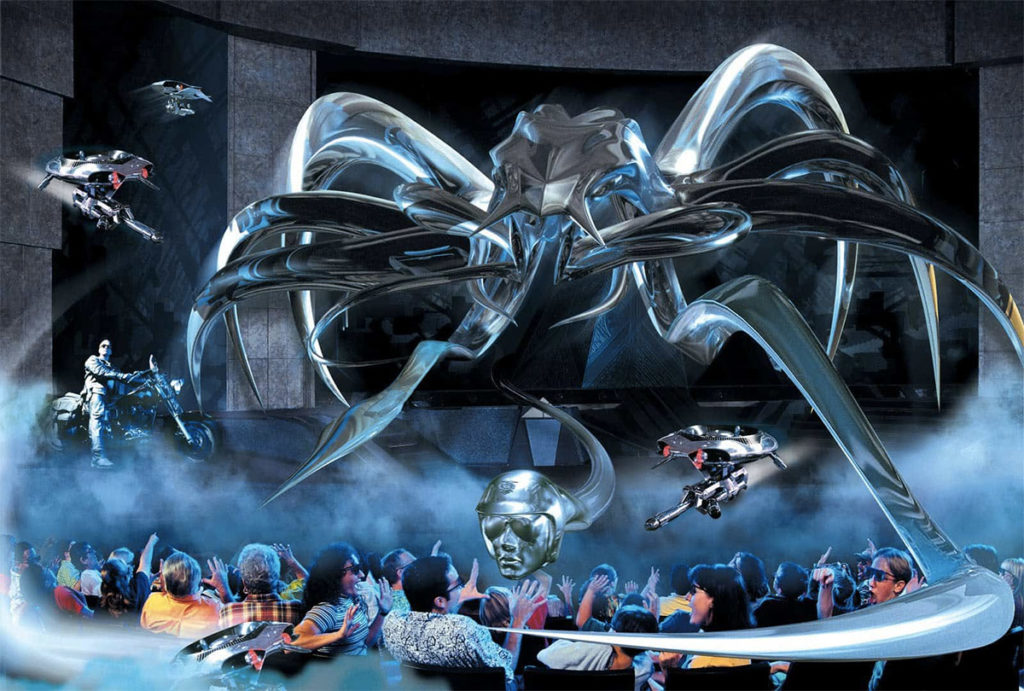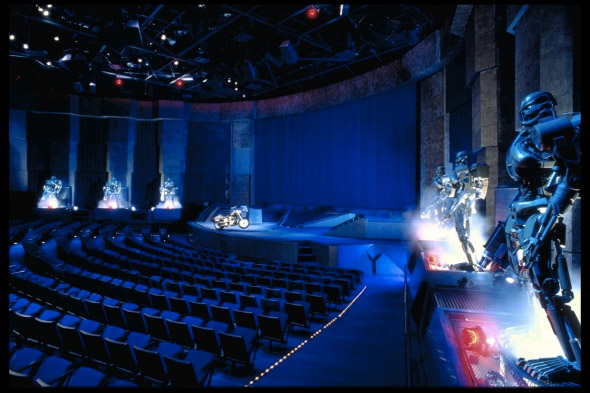It was late summer 1993, a few months after I had left the employ of Walt Disney Imagineering, when I got a phone call from a person I had worked with there. They were working on the concept for a new theme park attraction for another company and wanted me to come in for a meeting.
The meeting took place at Digital Domain, which was owned by James Cameron and a few others. The project had been developed by Landmark Entertainment and was for Universal and the title? T2-3D: Battle Across Time, based on the Terminator movies.
They had a storyline. They had a concept; a new one. 3D on three screens. The concept had a number of interesting and innovative gags including the Terminator (played by Arnold Schwarzenegger) John Connor and Sarah Connor not only in the three-screen film, but the characters would leave the film and show up as live actors in the theater. And in one of the show-stopping gags, the Terminator would fly out of the film and into the theater on a motorcycle.
The issue? None of these fun concepts for a 3D experience had been done before. But I had worked on projects like Muppet*Vision 3D and Captain EO at Disney, and some other projects that I could not talk about at the time, that had done some similar things – just not on that grand a scale.
I was asked to develop a test mock-up program to prove it out so that Universal would okay the project. I would work for Digital Domain, not Universal, as Cameron wanted things that way as he would also shoot the 3-screen film tests needed. The idea for the attraction had come Gary Goddard and his Landmark Entertainment company.
Initially, I looked at the concept drawing and the story line. There were no detail (show set) drawings developed yet, just a general artist concept drawing of a theater, with the three film screens shown, planned (at the time) as 60-feet wide each.
Sight lines were going to be the toughest thing to figure out, and where to put the projectors so that people could see the film, and not be in the path of the projected image. The team also needed to be able to have a basic understanding of how the motorcycle would leave the film and enter the theater – then leap back into the film. Finally, the finale involved 3D on all three screens at the same time in the image of the T-One Million, and that had never been done before.
I started by doodling some rough sketches of where the projectors might go. I started working out some of the stuff on paper, and researched different lenses, throw distances from projector to screen and more. I worked out a lot of the math involved and figured lenses, distances and the offset height of the projectors relative to the center of the screen.
I knew my doodles would not be good enough as I needed clear drawings to show the team at Digital Domain what I was planning, including James Cameron, so I commenced to work on them.
I had a MacIntosh Plus back then and made use of the drawing programs I had at the time. I made two drawings: a top drawing showing projectors, audience area, stage area and screens; and a side view showing heights and seating rake. The drawings also had all the specifications for projector throw and lenses. Due to limitations of the software, I had to print the two drawings onto twelve 8.5-inch by 11-inch printouts each – then matched them up to tape them together.
I took those two taped together drawings to Kinko’s and made several copies.
This was all up against a deadline of a meeting with James Cameron. During that meeting, I would show what I had come up with, and the production team would talk about the different test shoots needed, along with another consultant, well-versed in magical illusions and special effects, to talk about how to transition from film to theater and back again.
I was supposed to go last after the others in that meeting, but when James showed up, he insisted on looking over my drawings first.
What I liked about James was that he had a good grasp of the technical challenges of the theater. I told him we really needed to mock this up full-scale. He said “no problem” and if Universal was a problem to let him know.
Well, flush with that, it was time for the team to meet with the Universal and Landmark Entertainment folks. We met with them in a very large conference on the lot. There were several folks on their staff in the meeting, along with some folks from Landmark, some consultants Universal had retained and of course the Digital team.
Universal didn’t have anything in the way of drawings for us – we asked. So I volunteered that I had done a couple of drawings of the theater layout. You would have thought I was feeding starved dogs the way they swooped in. I think they were shocked that someone had committed something to paper with actual numbers.
The two Universal consultants’ purpose seemed to consist of throwing brickbats at what I had come up with, but in the end they found the specifications I had developed were solid.
The end result for me was to estimate the cost of the mock-up and submit a budget. The budget needed to include six-70-mm projectors, three 60-foot wide screens, scaffolding for the projectors, and a location to mock it up. There were no sound stages around big enough and available for a long period. We eventually found that an aircraft hangar at the old Hughes airport property north of LAX would work, and was available.
The budget was submitted, with a big contingency, and approved. The longest lead items were the screens – they came from a company in New York, and had to be shipped by truck.
Meanwhile, I created a special multi-color alignment chart for the 70mm projectors – based on my experience with the Muppet*Vision 3D project. One that would make it easier for the projection engineers to properly align the projectors onto each screen.
After several months we finally had it all done, including myself spending a long day taping out the floor to show where the audience would be seated. We even set up some chairs on risers to simulate the correct height of the seats to the screens.
We did a quick test shoot just to see 3D on three screens, then it was set for the full test shoot. Then something happened. The Northridge earthquake on January 17, 1994.
Because of all the damage done, including the destruction of part of the Santa Monica Freeway, no one on the team went to work. Finally, three days later, I ventured out and over to the mock up. I was pleasantly surprised to find that we had done a good job of tying down the three 27-foot tall scaffolding structures upon which the projectors sat. The screens were still in place too.
Two days later I had a projection team in to check alignment of the projectors; they only needed some minor adjustments. My work was complete, and so I went off payroll for a while. During that time, I did some consulting on EFX for the MGM Grand.
Finally, they called me back after they had filmed and put together the full test shoot, including some CG of the T-One Million character. They needed some special screenings set up. I came in and organized them for the Universal executives, along with the Digital Domain team, James Cameron and his team, and the Landmark team.
After a week of screenings, they went off and had meetings. At that time, Universal wanted to think about moving ahead with the project and didn’t want to spend any more money. So, I was told to tear down the mock up and put everything into storage. A couple of weeks later, I handed the keys to the hangar back to the property managers, and collected my last paycheck on that job.
A couple months later I was at Warner Bros. working on a 3D film project and was signed to a contract to write and produce that project. Two weeks after I signed that contract Universal called and wanted me to come back and be a producer on T2-3D for them but I had to turn them down due to the Warner Bros. deal.
They eventually had a large 3D screening facility created at Digital Domain, and I ended up renting it to screen 3D dailies for the Warner Bros. project. I ran into James Cameron a couple of times there; he was working on Titanic and in discussions with them about the models and special effects for that film.
When Universal finally got T2-3D done, I was invited out to the cast and crew screening of the finished film. They had built a mock-up in another airplane hangar, this time at the Van Nuys Airport. They had also downsized it slightly to 50-foot wide screens. Still, it was the same show we had done the tests for, and the same show that opened in California and Florida, and eventually in Japan.
Some of the great people I worked with on the project included: Peter Anderson, David Bartholomew, Adam Bezark, Cecil Kramer and Amy Jupiter.



